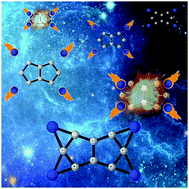Carbon rings decorated with group 14 elements: new aromatic clusters containing planar tetracoordinate carbon†
Abstract
A simple and chemically intuitive approach is used to design ptC-containing E–C clusters (E = Si–Pb). This approach consists in replacing three or two consecutive protons from an aromatic hydrocarbon by one E24+ or one E2+ fragment, respectively. In the model, electrons from E are removed from the pz orbitals, emptying them. Si–Pb favors the formation of a 3c-2e (E–C–E) σ-bond, which involves the ptC. Additionally, the π-electronic cloud is delocalized through the E-pz orbitals allowing the E atoms to effectively take part in the electronic delocalization, preserving the 4n + 2 Hückel's rule from the parent hydrocarbon. Two aromatic monocycles and one aromatic bicycle – benzene (C6H6), cyclopentadienyl anion (C5H5−) and pentalene dianion (C8H62−) – have been transformed into C–E systems. After an extensive exploration of their potential energy surfaces, four new global minima with ptC are identified, resulting from the substitution of the protons by Si and Ge cations in C5H5− and C8H62− (E3C5 and E4C8). The analysis of both the chemical bonding and the magnetic response to an external magnetic field confirms the aromatic character of these species.



 Please wait while we load your content...
Please wait while we load your content...